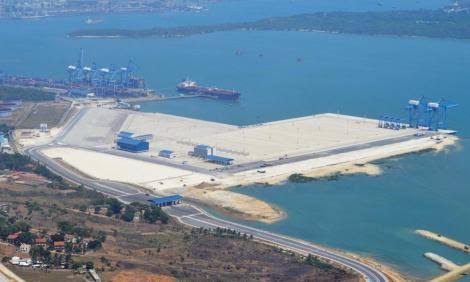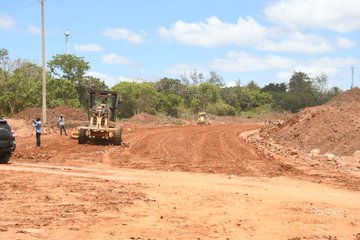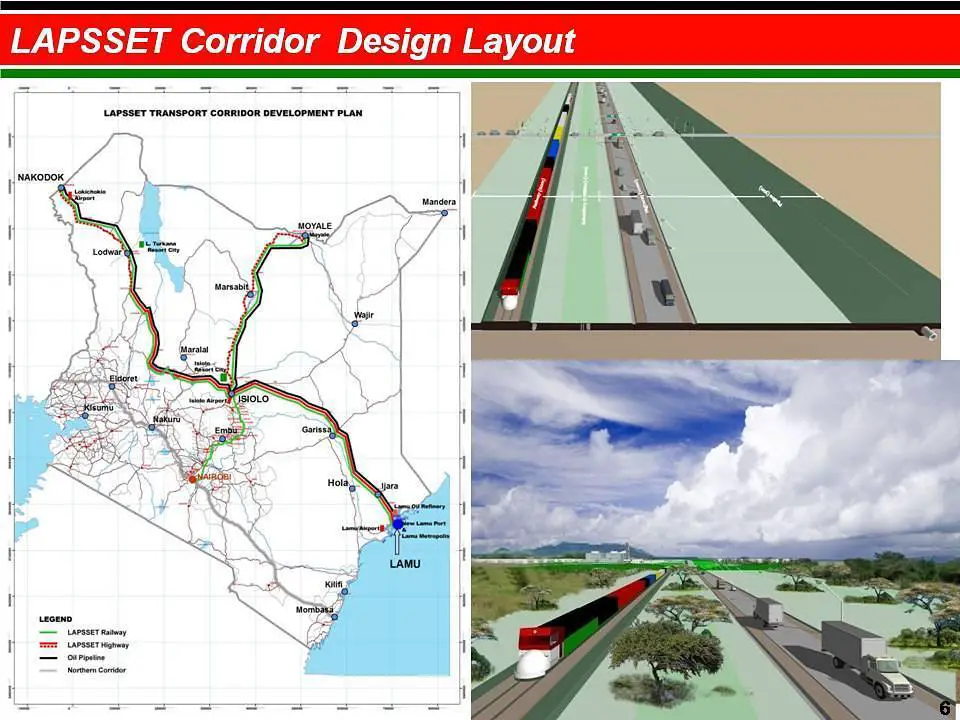Stephen Ikua has been appointed by the Cabinet Secretary for the Ministry of East African Community and Regional Development, Adan Mohamed, to serve as the new Director-General and CEO of the LAPSSET Corridor Development Authority (LCDA) for a period of 60 months.
Mr. Ikua takes over from Maina Kiondo, who has been serving as the acting Director-General and CEO of the LCDA since January last year (2021).
The new Director-General brings with him over 30 years of experience in the public sector, having served as the County Commissioner for both Lamu and Turkana counties, which are significant in the implementation of the LAPSSET Corridor Program.
Mr. Ikua also participated in the conceptualization and design of the LAPSSET Corridor program and has vast experience in regional development matters owing to his engagement in various capacities in Government.
Responsibility of new DG & CEO of LAPSSET Corridor Development Authority
At the helm of the LCDA, Mr. Ikua will coordinate and oversee the developments of the LAPSSET Corridor Projects including the growth of business and development of the Port of Lamu and Isiolo Airport, and the development of the Lamu Special Economic Zone.
This is in addition o the completion of road infrastructure linking the Port of Lamu to Ethiopia and South Sudan, the development of a crude oil pipeline as well as planning for the LAPSSET railway project, resort cities, future airports, and various utility infrastructure.
The new DG & CEO is also expected to synergize County and National Government efforts in planning for the urban growth and economic development of the LAPSSET Outer Corridor, which traverses a total of seven counties, and champion resource mobilization and investment strategies for the LAPSSET corridor projects, foster strong ties with regional countries as well as manage stakeholders’ and community interests.
Before his appointment, Mr. Ikua was in charge of administration at the Ministry of East African Community and Regional Development where he oversaw the Kenya South-Sudan Liaison Office.
Project Overview
The (Lamu Port-South Sudan-Ethiopia-Transport) LAPSSET corridor project, is a transport and infrastructure scheme in Kenya. After completion, it will be the second transport corridor in the country, the other being the Mombasa – Uganda transport corridor which passes through Nairobi and parts of the Northern Rift.
Some of the basic LAPSSET infrastructure have already been constructed; I.e a harbor office and police station in Lamu and revamping of the Lamu airport runway.
 The LAPSSET corridor project plan combines different elements: the construction of a new port at Lamu; a Lamu- South Sudan oil pipeline and roads and railways linking possibly to west and southern Ethiopia. A new international airport and resort cities along the rail will also be constructed. Any of the element’s completion will have a great impact on which combination would transform the region.
The LAPSSET corridor project plan combines different elements: the construction of a new port at Lamu; a Lamu- South Sudan oil pipeline and roads and railways linking possibly to west and southern Ethiopia. A new international airport and resort cities along the rail will also be constructed. Any of the element’s completion will have a great impact on which combination would transform the region.
The 200m-wide LAPSSET corridor will join Juba with Kenya’s coast of Lamu, 1,700 km away. It is expected that the corridor will form a part of the future equatorial ‘land bridge’ connecting Western and Eastern Africa through Juba, and Bangui in the Central African Republic, to Douala, Cameroon. Road links are also planned to Addis Ababa through Moyale in Kenya.
The aim of the scheme is to cut Kenya’s main port of Mombasa overdependence and also open up the largely under-developed northern frontier, through the creation of the LAPSSET corridor. The project’s key towns are Lamu and Isiolo in Kenya, South Sudan’s Juba, and Addis Ababa in Ethiopia.
The seven main infrastructure scheme components in the LAPSSET Corridor Program require quite a higher amount of resources with a budget estimate of US$24.5 billion. It is projected that Lamu Port with the 22 berths alone will have an approximate cost of US$3.1 billion, the Railway US$7.1 billion, and the crude oil pipeline costing a further estimate of US$3 billion in the single Lamu to Lokichar trunk line.
Timeline.
2012
The government held a groundbreaking ceremony for the LAPSSET Corridor project at the Lamu Port site on 2 March.
2013
In March, the LAPSSET Corridor Development Authority (LCDA) was formed according to the Presidential Order Kenya Gazette Supplement No. 51, Legal Notice No. 58, The LAPSSET Corridor Development Authority Order 2013 to plan, manage and coordinate the implementation of the Lamu Port-South Sudan-Ethiopia Transport Corridor scheme.
2014
Construction of Marsabit – Turbi (123 km) road. The road starts in Marsabit at the junction with road C82 and runs through the north and terminating in Turbi constituting the 505 km road third section from Isiolo through Moyale to Addis Ababa in Ethiopia. The construction works started in April 2011, under the African Development Bank funding.
August 2014
Africa Leaders summit platform for East African leaders to continue sourcing for US$24bn Lapsset funds
The Us Africa leaders summit kicks off this week with more than 40 African leaders meeting US president Barrack Obama in Washington DC, USA. The summit is aimed at strengthening the bond between the USA and African nations. It will highlight America’s commitment to Africa’s security, its democratic development, and its people.
The theme of the Summit is “Investing in the Next Generation.” Four East African leaders from Kenya, Ethiopia, Uganda, and South Sudan will take this opportunity to source funds from investors for the US$24bn Lamu Port-South Sudan-Ethiopia-Transport (LAPSSET) Corridor Project.
The project is under Kenya’s vision 2030 strategy which seeks to strengthen the country’s position as a gateway and a transport and logistics hub to the East African sub-region. Key towns in the project are Lamu and Isiolo in Kenya, Juba in Southern Sudan, and Addis Ababa in Ethiopia. Isiolo, in Kenya, is already adjusting its landscape to cater to the corridor once completed, with various construction projects taking place with investors already flocking to the area.
Lamu, on the other hand, has been a thorn with violence rocking the area. The violence was attributed to the illegal allocation of land in the area to a few companies that owned large tracts of land. The president had to revoke title deeds for the 500,000 acres of land that is said to have been grabbed. Despite the challenge, the four countries are hopeful that the project will kick off smoothly and open up the region for more trade.
The heads of state from the four countries met at State House Nairobi where the leaders agreed to take a common stand on the project and submit the package to American investors. The summit will be a forum where American investors and African leaders have a platform to interact and find ways of moving the continent forward.
2015
Construction of Turbi – Moyale (125 km) road. Construction works started in October 2012 for a period of 36 months. The section was also funded by the African Development Bank.
December 2015
Construction work at Lamu port slows down over funds
Kenya Ports Authority (KPA) has announced that construction of the first three berths at Lamu Port has been slow due to financial issues. KPA says that Treasury has been releasing money for the project intermittently, delaying construction works at the site.
Managing director Gichiri Ndua said that Construction of the three berths at Lamu Port is ongoing but work is continuing at a sluggish pace. He however expressed confidence that the project will pick up. The Lamu Port project was launched by former President Mwai Kibaki in 2012.
Development of the entire $23 billion (Sh2.3 trillion) Lamu Port-Southern Sudan-Ethiopia Transport Corridor project has also been stalled as a result of new infrastructure projects in Ethiopia, Uganda, and Tanzania.
The $ 4 billion (Sh408.2 billion) project is expected to increase Djibouti port capacity by Ethiopia which facilitates 80 percent of its international trade.
Uganda is also considering an alternative crude oil pipeline route, having signed an agreement with Tanzania for feasibility studies of an oil pipeline from Hoima to Tanzania’s Tanga port.
Treasury CS Henry Rotich also said Kenya is still pursuing the crude oil pipeline deal.
President Uhuru has postponed thrice the launch of the Berth construction with the latest being on May 25.
The LAPSSET project includes a 32 berths port at Manda Bay, a Standard Gauge Railway line to Juba and Addis Ababa, a road network, oil pipelines (Southern Sudan, and Ethiopia), an oil refinery, three airports and resort cities at Lamu, Isiolo, and Lake Turkana.
2016
Construction of Merille River – Marsabit (121 km) road. The road forms the second part of the 505 km road from Isiolo through Moyale to Addis Ababa in Ethiopia.

The road starts at Merille River and runs north to Marsabit.
October 2016
Lapsset receives a new breath of life
The Lamu Port South Sudan Ethiopia transport corridor (Lapsset) project has received a major impetus after a consortium of international investors led by the Development Bank of South Africa (DBSA) said that they will help finance the project.
According to State House, the consortium has already agreed to inject over ($1.9 billion) into the Lapsset project in the next few months. This is going to be a great boost to the project as recently it has slowed its momentum as there have been insufficient funding and the investors are interested in putting up three berths at the Lamu Port and financing the construction of the 537-kilometer Lamu-Garissa-Isiolo road.
According to the State House spokesman Manoah Esipisu both the Kenyan government and the South African had signed an MOU on the Sh2.5 trillion projects during the visit by President Jacob Zuma last week. He said that the visit of President Zuma to Kenya was beneficial and they expect more development to be announced in the next few weeks. The DBSA is wholly owned by the South African government and has arranged to fund projects in the transport, energy, water, and ICT sectors.
“The Development Bank of Southern Africa remained to be the main consortium as they have already agreed to inject ($1.2 billion) into the project so that it can get going and the three additional berths at Lamu Port. The same consortium would look to fund construction of the Lamu-Garissa-Isiolo road under the annuity program at a cost of Sh71 billion ($700 million),” said Mr. Esipisu.
The Lapsset project, which was commissioned by former President Mwai Kibaki in 2012, is expected to open up Kenya’s northern frontier for more trade and investment and has been identified as the long-term conduit for Kenya’s oil exports through a crude pipeline linking Lamu to the oilfields in Turkana County. But the project has been hit by contraction delays due to financial problems after several financing countries withdrew.
February 2017
South Africa banks on Lapsset to boost relations with Kenya
South Africa has said it will reinforce its economic ties with Kenya, particularly in regions of infrastructure particularly Lapsset in an effort to make stronger trade and investment ties. High Commissioner Koleta Anita Mqulwana said both countries stand to gain greatly if they join forces in infrastructure, agriculture, business, tourism, education, and health. Ms. Mqulwana said South African companies were interested in Kenya’s Lamu Port-South Sudan-Ethiopia-Transport (Lapsset).
“Late last year, South African President Jacob Zuma met his Kenyan counterpart Uhuru Kenyatta and they signed six contracts among them Lapsset Corridor Project. South African companies are going to contribute to that development; a lot has been done and a lot needs to be done,” she said.
The emissary said the partnership will generate job opportunities for the youths. “If they are not occupied they will end up killing some of us. We need to tackle regions of poverty. That is why I am visiting companies,” she said in Mombasa. “You are producing a lot of mangoes here which I am interested in because if we get mango juice from Kenya it will be less expensive than importing the same from Brazil,” she said.
She said Mombasa County is a strategic area for South Africa because of the port. “Additionally, it has a sister-to-sister agreement with Durban, we have to fortify the affairs. We have to do business among ourselves as Africans to construct stronger trade and investment ties.” She asked Kenyan scholars to study in South Africa, adding they have some of the best universities that are acknowledged across the globe.
Ms. Mqulwana who was escorted by the embassy’s economic counselor Njabulo Mbewe and Gerald Ockotch, senior marketing officer said South Africa is letting-up visa requirements for business people and students to boost relations between the two nations. She said the two states can build and improve social unity in sports and cultural tourism, which will in the end generate job opportunities. Ms. Mqulwana said Kenya can advance its medical services by constructing the right infrastructure.
May 2017
Lapsset construction project faces legal challenge
2019
The first berth in Lamu port was completed in August.  The second and third berths were scheduled for completion in December 2020. The cargo capacity at the fully completed Lamu Port was set to reach 23.9 million tonnes by 2030.
The second and third berths were scheduled for completion in December 2020. The cargo capacity at the fully completed Lamu Port was set to reach 23.9 million tonnes by 2030.
August 2019
Kenya’s government seeks the support of the AU for the Lapsset project
The government of Kenya is seeking support from the African Union (AU) for the US $22.3bn trillion Lamu Port-Southern Sudan-Ethiopia Transport Corridor (Lapsset) project. Lapsset Corridor Development Authority announced the reports and said that a strong case has been made to the AU on the Lapsset project’s strategic position to connect not only Ethiopia and South Sudan, but also connecting to Central African Republic (Bangui) and Cameroon, terminating at Port of Douala.
“AU’s special envoy plans to convene a high-level meeting with the countries that fall along Africa’s equatorial land bridge later in the year with an aim of forming these crucial transport infrastructure linkages within the continent,” said the authority in a statement.
Lapsset project
The Lapsset project was launched in 2012 by former President Mwai Kibaki and is also among the nine Presidential Infrastructure Championship Initiatives (PICI) under the AU. Such projects are championed by respective African Heads of State and Government.
It is also a Programme for Infrastructure Development in Africa (PIDA), a strategic continental initiative that has the support of all African countries, for mobilizing resources to transform Africa through modern infrastructure. This mega project consists of seven key infrastructure projects starting with a new 32 Berth port at Lamu (Kenya);
Interregional Highways from Lamu to Isiolo, Isiolo to Juba (South Sudan), Isiolo to Addis Ababa (Ethiopia), and Lamu to Garsen (Kenya), Crude Oil Pipeline from Lamu to Isiolo, Isiolo to Juba; Product Oil Pipeline from Lamu to Isiolo, Isiolo to Addis Ababa; Interregional Standard Gauge Railway lines from Lamu to Isiolo, Isiolo to Juba, Isiolo to Addis Ababa, and Nairobi to Isiolo;
3 International Airports: one each at Lamu, Isiolo, and Lake Turkana; 3 Resort Cities: one each at Lamu, Isiolo, and Lake Turkana; and The multipurpose High Grand Falls Dam along the Tana River.
The project however has since experienced cash constraints and a lack of political goodwill which has slowed down its implementation. Ethiopia is seen to have shifted focus to the port of Djibouti. Road and rail infrastructure between the two countries including the Ethio-Djibouti railway passenger and freight system, which commenced on January 1, 2018, seems to have also shifted interest away from the Lapsset corridor.
High Representative for Infrastructure Development in Africa, Raila Odinga noted that the Lapsset corridor project has the potential to boost Africa’s regional social-economic integration through infrastructure development and trade.
“Regional infrastructure projects such as the Lapsset are strong enablers of Africa’s continental integration and these coupled with the establishment of the African Continental Free Trade Area, harmonization of monetary policies and other standards such as customs, stabilization of tariff and non-tariff barriers, statistics and labor market information and improved business climate, will attract global trade and investments in Africa,” said Odinga.
Also in August 2019
LCDA announces completion of LAPSSET’s first berth at Lamu port
The LAPSSET Corridor Development Authority (LCDA), which is in charge of the coordination and management of the implementation of the Lamu Port-South Sudan-Ethiopia Transport Corridor, has announced that the first of the proposed 32 berths at the Lamu port is now 100% complete.
This berth is one of the three berths whose construction began with dredging works in December 2016 with a delivery time of 24 months; and 45 months for the other two, all at a cost of US $480m. LCDA stated that berths 2 and 3 will be completed by December next year.
Financing construction of the berths
The government of the Republic of Kenya is fully funding the construction of the 1st three berths under a plan referred to as the “Short-term Plan” that is estimated to cost US $689m, accounting for dredging and reclamation; construction of berths and yards; construction of revetment, causeway, and road; construction of buildings and utilities including Port headquarters,
Port Police Station and Port Management Housing Scheme; procurement of equipment and tug boats; and Electric Power Connection to the National Grid and establishment of Water Reticulation Network among others. The government has structured the remaining 29 berths to be handed over to private sector investors for financing, construction, and operation.
Benefits of the Lamu port
Once complete, Lamu port is expected to create job opportunities not only in port operations but also in agriculture, fishery, manufacturing, logistics, transport, trade, and commerce. In addition, the port is predicted to appeal to large cargo ships and provide benefits in the region by passing on savings as a result of lower marine costs due to faster ship turnaround time, reducing the cost of doing business.
January 2020
Kenya, Ethiopia, and South Sudan sign MoU to reinvigorate Lapsset
Kenya, Ethiopia, and South Sudan have signed a Memorandum of Understanding (MoU) to commit to the re-invigoration of the Lapsset project. Transport Cabinet Secretary James Macharia joined Ethiopian Ambassador to Kenya Meles Alam and South Sudan’s Undersecretary in the Ministry of Transport Capt David Martin to sign the MoU, which will see among other things, the initiation of dialogue between LAPSSET footprint States towards a shared approach and support establishment of an umbrella body to coordinate the implementation of the corridor.
According to Ambassador Alam Ethiopia is still fully committed to the implementation of the project despite the peace deal with Eritrea signed in 2018. “Our presence in this meeting testifies to the full commitment the Ethiopian government has towards implementation of this project,” he affirmed. He further added that Ethiopia has constructed over 500km of tarmac road from Moyale, which is part of the Lapsset project.
“We have also built industrial zones in the Southern parts of Ethiopia. We are now looking forward to the inauguration of the first berth of the Lamu Port because the southern part of Ethiopia will depend on the Port,” he said.
Spurring regional economic growth
Also present at the signing ceremony was African Union High Representative on Infrastructure Raila Odinga who emphasized on how crucial Lapsset is when it comes to spurring trade and economic growth in the region. “A two-day meeting of the technical committee was held here in Mombasa. It was convened under the auspice of Africa Union and it was basically to give this project the impetus that it can be implemented quickly,” said Mr. Odinga.
South Sudan’s Undersecretary in the Ministry of Transport also reaffirmed his government’s commitment to the actualization of the Lapsset project. LAPSSET was launched on March 2, 2012, by the then Kenyan President Mwai Kibaki, late Ethiopian Prime Minister Meles Zenawi, and South Sudan’s President Salva Kiir.
May 2021
Kenya National Highway Authority (KeNHA) signed a deal with China Communications Construction Company totaling 17.9 billion shillings (about 166 million U.S. dollars) for the construction of a 453-km road which is part of the Lamu Port-South Sudan-Ethiopia Transport (LAPSSET) corridor scheme  Roads included were 257-km Lamu-Ijara-Garissa part as well as the Hindi-Bodhei-Basuba-Kiunga part which spans 113 km and the section of Ijara-Sangailu-Hulugho of 83 km.
Roads included were 257-km Lamu-Ijara-Garissa part as well as the Hindi-Bodhei-Basuba-Kiunga part which spans 113 km and the section of Ijara-Sangailu-Hulugho of 83 km.
August 2021
The completion of the remaining works in the Isiolo International Airport in Kenya is fast-tracked to offer swift movement and full operations in January 2022.

The remaining works included the ongoing cargo sheds construction and runway extension from the current 1.4 km to 2.5 km. The cargo sheds are planned to be completed by the end of September 2021. The construction will allow them to handle at least 10 tonnes of luggage. The extension of the runway is expected to end by December 2021, giving way to the beginning of the flight’s operation.
January 2022
Construction of the first phase of Kenya’s $400 million second commercial port in Lamu was completed. The second and third berths construction was completed in December, giving way for the government to float a contract to private companies to develop 20 more berths under a public-private partnership to finish the 23-berth facility.  “Yards and the first three berths at the Port of Lamu are completed with plans to commence operations at berths second and third berths in 2022. KPA is obtaining modern equipment as well as three mobile harbor cranes and ship-to-shore gantry cranes, complementing the port’s operations,” stated Kenya Ports Authority (KPA).
“Yards and the first three berths at the Port of Lamu are completed with plans to commence operations at berths second and third berths in 2022. KPA is obtaining modern equipment as well as three mobile harbor cranes and ship-to-shore gantry cranes, complementing the port’s operations,” stated Kenya Ports Authority (KPA).
The first Phase included the construction of the first three berths and the infrastructure associated, having a length of 400 meters and a depth of 17.5 meters each. The berths were designed for the container, general, and bulk cargo.

Nice progress so far